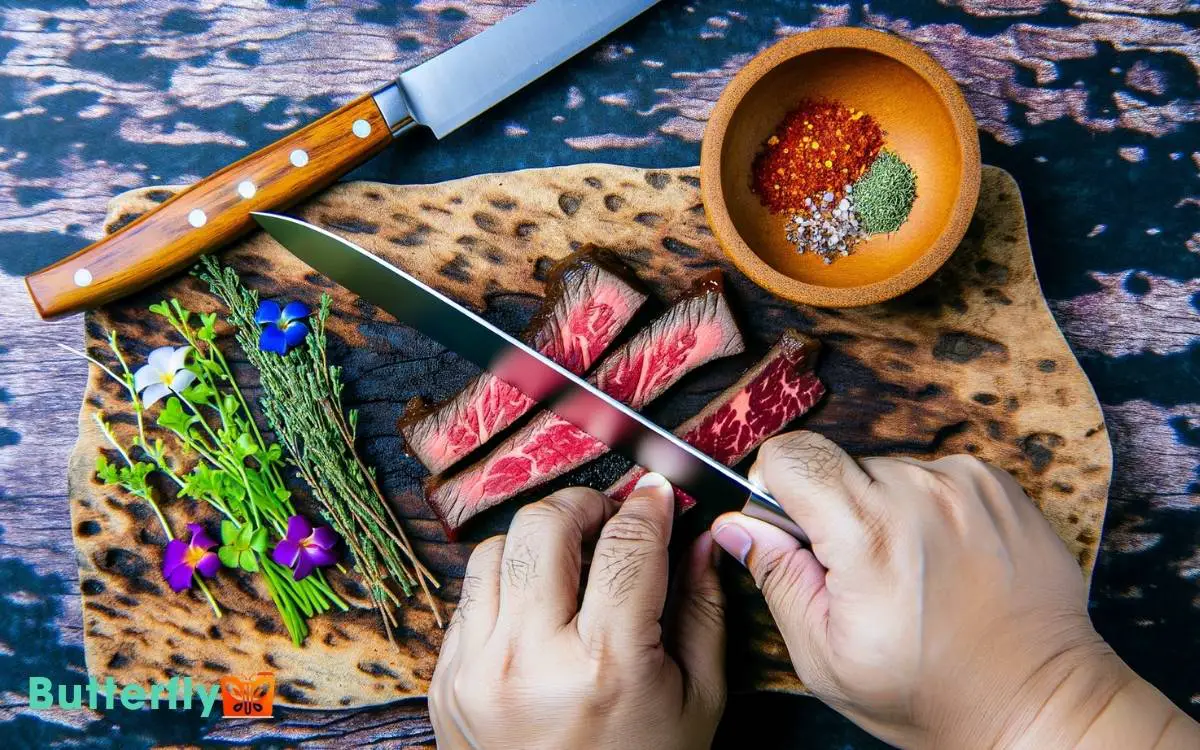How To Butterfly A Flank Steak? Step-by-Step Instructions!
To butterfly a flank steak, first gather a sharp chef’s knife, cutting board, and kitchen shears. Trim excess fat, then pat the steak dry. Identify the grain and place the steak on the board.
Begin by making a horizontal cut along one edge, progressing slowly to maintain an even thickness. Open the steak like a book, ensuring consistency.
Use a meat mallet to flatten it evenly. This technique guarantees consistent cooking and enhances flavor. If you’re curious about mastering each step meticulously, more guidance is available.

Key Takeaways
Gather Your Tools
Before you begin, you’ll need to gather a sharp chef’s knife, a sturdy cutting board, and a pair of kitchen shears. Precision and control are essential, so make sure your knife is well-honed. A dull blade increases the risk of uneven cuts and potential injury.
Your cutting board should be stable and spacious, providing ample room to maneuver the steak. Non-slip boards are ideal to prevent any movement during the process.
Kitchen shears are vital for trimming excess fat and any unwanted sinew. Clean, efficient tools not only streamline your work but also enhance the quality of your final product.
Investing in high-quality kitchen equipment will yield more precise results and elevate your culinary techniques to professional standards.
Prepare the Flank Steak
- First, make sure you select a high-quality flank steak with good marbling.
- Next, trim any excess fat to prevent flare-ups during cooking.
Choose Quality Meat
Selecting a high-quality flank steak is crucial for achieving the best results. Look for a cut that’s bright red with minimal marbling and a uniform thickness.
Freshness is paramount; make sure the meat has a vibrant color and is firm to the touch. The grain should be clearly visible and run lengthwise, which will be crucial for both butterflying and eventual slicing.
Opt for USDA Prime or Choice grades to guarantee superior tenderness and flavor. Avoid steaks with discoloration or excessive moisture, as these indicate subpar quality.
By prioritizing these characteristics, you’ll establish a solid foundation for a beautifully butterflied flank steak, ensuring a top-notch culinary experience.
Trim Excess Fat
With a top-quality flank steak in hand, start by trimming any excess fat to guarantee even cooking and best flavor. Position the steak on a clean cutting board.
Using a sharp knife, hold it at an angle and carefully slice away any visible fat. Make sure to remove only the excess fat, leaving some for flavor. Work methodically, making certain you don’t cut into the meat itself.
Pay special attention to any thick fatty areas, as these can cause uneven cooking. Once you’ve trimmed the steak, inspect it for any remaining sinew or silverskin, and remove these as well.
This precise preparation ensures a tender, evenly-cooked steak, ready for the next steps in the butterflying process. The meat is carefully sliced to create a uniform thickness, allowing for even cooking and enhanced flavor absorption. To successfully butterfly a tenderloin stepbystep, one must make precise cuts and gently open the meat like a book. This technique not only improves texture but also provides a perfect surface for fillings or seasonings.
Pat Steak Dry
Before moving on to the butterflying process, pat the flank steak dry with paper towels to guarantee a good sear and prevent excess moisture. This step is essential for achieving the best texture and flavor.
Excess moisture can interfere with browning, leading to a steamed rather than seared steak. Use firm, even pressure to blot all sides of the steak until no visible moisture remains.
Here’s a quick process overview:
| Step | Description | Purpose |
|---|---|---|
| 1. Unwrap | Remove steak from packaging | Access the steak |
| 2. Inspect | Check for defects | Ensure quality |
| 3. Trim | Remove excess fat | Prepare for cooking |
| 4. Pat Dry | Use paper towels | Remove moisture |
| 5. Season | Apply salt and pepper | Enhance flavor |
Taking these steps ensures your flank steak is ready for the next phase of preparation.
Trim Excess Fat
To guarantee even cooking and enhance the steak’s flavor, meticulously trim any excess fat from the flank steak using a sharp knife. By removing excess fat, you’ll secure a consistent texture and avoid flare-ups during grilling.
Hold the knife at a slight angle and carefully slice away any large chunks of fat. Be precise to prevent cutting into the meat itself, which could impact its integrity.
Consider the following:
- Precision: Use a sharp, flexible knife for better control.
- Safety: Keep fingers clear of the blade to avoid accidents.
- Angle: Hold the knife at a 45-degree angle for best fat removal.
- Consistency: Trim uniformly to prevent uneven cooking.
- Inspection: Regularly inspect the steak to identify and remove any remaining fat pockets.
Find the Grain
To properly butterfly a flank steak, you must first identify the grain, which refers to the direction of the muscle fibers. Use visual inspection techniques to locate these fibers running parallel across the steak.
Cutting against the grain is essential for achieving a tender texture in the final dish.
Identifying Muscle Fibers
Recognizing the grain of the meat is vital for guaranteeing a tender and properly butterflied flank steak. The grain refers to the direction of the muscle fibers, which impact how the meat cuts and chews.
To identify the grain:
- Inspect the surface: Look for lines running across the steak.
- Feel the texture: Run your fingers along the meat; fibers will be distinct.
- Use lighting: Good light helps highlight the grain.
- Cut with the grain: Make initial cuts parallel to the fibers for clarity.
- Verify alignment: Ensure all cuts align with the grain direction.
Mastering this step enhances tenderness by allowing you to make precise cuts against the grain later, optimizing the meat’s texture and flavor profile.
Visual Inspection Techniques
Begin by visually examining the surface of the flank steak under good lighting to detect the direction of the muscle fibers.
These fibers, known as the grain, appear as parallel lines running across the meat. Identifying this grain correctly is crucial to guarantee proper cutting techniques later.
| Step | Description | Result |
|---|---|---|
| 1 | Place steak on a flat surface | Ensures stability and a clear view |
| 2 | Look for parallel lines in the meat | Identifies the direction of the grain |
| 3 | Rotate the steak if necessary | Confirms consistent grain direction |
| 4 | Mark the grain direction with a light score (optional) | Aids in future cuts |
Detecting the grain’s direction simplifies subsequent steps, making sure your butterflying process is precise and effective.
Cutting Against Grain
Always cut against the grain for a more tender and flavorful result when butterflying a flank steak. To identify the grain, look for the direction in which the muscle fibers run. Cutting against these fibers shortens them, making the steak easier to chew.
Follow these steps:
- Inspect the steak: Lay it flat and look for the lines of muscle fibers.
- Position the knife: Align your knife perpendicular to these lines.
- Make precise cuts: Slice through the fibers with a smooth motion.
- Verify the cut: Confirm each slice is consistent in thickness.
- Repeat if necessary: Continue cutting until the entire steak is butterflied.
Start the Cut
Position the flank steak on a clean cutting board with the grain running parallel to your body. Using a sharp knife, place your hand flat on top of the steak to stabilize it.
Carefully make a horizontal cut along the long edge of the steak, ensuring you’re slicing into the center. Keep the blade parallel to the cutting board to maintain an even thickness. Progress slowly, allowing the knife to guide through the meat without piercing the opposite side.
Precision is key aim for a consistent cut that enhances even cooking and ideal texture. By taking your time, you’ll achieve a professional butterfly that’s ready for the next step.
Open the Steak
Gently spread the two halves of the flank steak apart, making sure they remain connected along the uncut edge. This technique allows you to maximize surface area for even cooking and seasoning.
Carefully open the steak like a book, keeping the integrity of the meat intact. To achieve the best results, consider the following:
- Uniformity: Make sure the thickness is consistent throughout.
- Knife Control: Use smooth, deliberate motions.
- Angle Maintenance: Maintain a steady angle to avoid uneven cuts.
- Clean Surface: Work on a sanitized cutting board.
- Patience: Take your time to avoid tearing the meat.
Flatten and Even Out
Using a meat mallet, flatten the opened flank steak to an even thickness, ensuring uniform cooking and seasoning absorption. Lay the steak between two sheets of plastic wrap or parchment paper to prevent tearing.
Begin from the center, gently working your way outwards. Maintain a consistent pressure to achieve an even thickness throughout. Aim for a uniform thickness of about half an inch.
Once flattened, inspect the steak for any uneven areas and rework them as needed. This step is vital for achieving a tender, evenly cooked steak.
Conclusion
You’re now well-equipped to butterfly a flank steak with precision. By following these steps, you’ve transformed a simple cut of meat into a canvas ready for your culinary masterpieces.
Remember, practice makes perfect. As you hone your skills, the steak will yield to your knife like butter, ensuring even cooking and delicious results.
With tools in hand and technique mastered, you’re ready to elevate your dishes to a professional level. Happy cooking!






